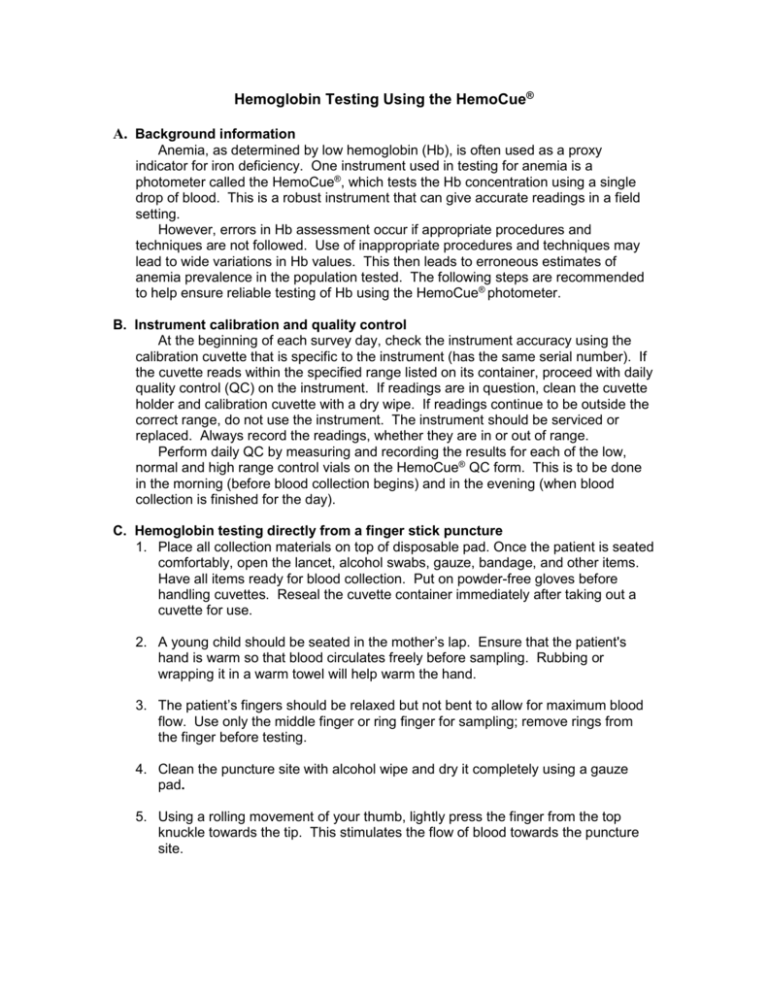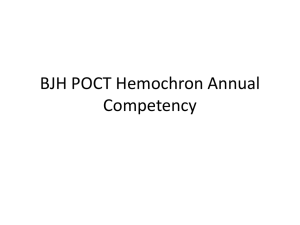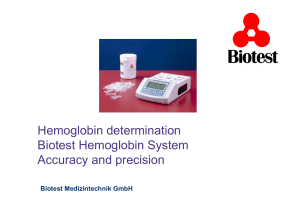HemoCue Hb testing - Micronutrient Initiative
advertisement

Hemoglobin Testing Using the HemoCue® A. Background information Anemia, as determined by low hemoglobin (Hb), is often used as a proxy indicator for iron deficiency. One instrument used in testing for anemia is a photometer called the HemoCue®, which tests the Hb concentration using a single drop of blood. This is a robust instrument that can give accurate readings in a field setting. However, errors in Hb assessment occur if appropriate procedures and techniques are not followed. Use of inappropriate procedures and techniques may lead to wide variations in Hb values. This then leads to erroneous estimates of anemia prevalence in the population tested. The following steps are recommended to help ensure reliable testing of Hb using the HemoCue® photometer. B. Instrument calibration and quality control At the beginning of each survey day, check the instrument accuracy using the calibration cuvette that is specific to the instrument (has the same serial number). If the cuvette reads within the specified range listed on its container, proceed with daily quality control (QC) on the instrument. If readings are in question, clean the cuvette holder and calibration cuvette with a dry wipe. If readings continue to be outside the correct range, do not use the instrument. The instrument should be serviced or replaced. Always record the readings, whether they are in or out of range. Perform daily QC by measuring and recording the results for each of the low, normal and high range control vials on the HemoCue® QC form. This is to be done in the morning (before blood collection begins) and in the evening (when blood collection is finished for the day). C. Hemoglobin testing directly from a finger stick puncture 1. Place all collection materials on top of disposable pad. Once the patient is seated comfortably, open the lancet, alcohol swabs, gauze, bandage, and other items. Have all items ready for blood collection. Put on powder-free gloves before handling cuvettes. Reseal the cuvette container immediately after taking out a cuvette for use. 2. A young child should be seated in the mother’s lap. Ensure that the patient's hand is warm so that blood circulates freely before sampling. Rubbing or wrapping it in a warm towel will help warm the hand. 3. The patient’s fingers should be relaxed but not bent to allow for maximum blood flow. Use only the middle finger or ring finger for sampling; remove rings from the finger before testing. 4. Clean the puncture site with alcohol wipe and dry it completely using a gauze pad. 5. Using a rolling movement of your thumb, lightly press the finger from the top knuckle towards the tip. This stimulates the flow of blood towards the puncture site. 6. When the thumb has reached the fingertip, maintain gentle pressure and puncture the palm side surface of the finger halfway between the nail and the finger pad with a sharp, quick motion. Using this spot on the finger causes less pain and produces the best flow of blood. Dispose of the lancet immediately into a Sharps container. 7. Using a dry gauze pad, wipe away the first two drops of blood to stimulate spontaneous blood flow. If necessary, gently press the finger until another drop of blood appears. Avoid "milking" the finger. Ensure that the third drop of blood is big enough to fill the cuvette completely in one attempt. 8. Fill the cuvette by touching its pointed tip to the middle of the blood drop and counting to three before removal. The cuvette fills automatically by capillary action, which helps avoid trapping air in the cuvette. Never “top off” the cuvette after the first filling. If the cuvette is not filled with the first attempt, discard it in the Sharps container and use a second cuvette. 9. If a second sample is taken from the same puncture site, it should be collected before clotting has occurred. Wipe away the remains of the previous blood drop, apply gentle pressure to form another adequate blood drop, and collect the sample as described above. 10. Clean any excess blood from the cuvette using a lint-free wipe. Do not touch the open end of the cuvette with the wipe. Inspect the cuvette for air bubbles. 11. Place the cuvette in its holder and gently push the holder into the photometer. The results will be displayed in approximately 15-45 seconds and will remain displayed for 4 minutes or until the slide arm is pulled out for removal of the cuvette. Record your results. Dispose of the cuvette in the Sharps container. Dispose all other materials in the biohazard bag. D. Hemoglobin testing from a Microtainer® or Vacutainer® 1. Place all collection materials on top of disposable pad. Once the patient is seated comfortably, open the lancet, alcohol swabs, gauze, bandage, and other items. Have all items ready for blood collection. 2. Put on powder-free gloves. Turn patient’s hand upward. Massage patient’s hand and lower part of the finger to increase blood flow. 3. Scrub the patient’s middle finger or ring finger with an alcohol swab. Dry with gauze. 4. Hold the finger in an upward position and puncture the palm side surface of the finger with the proper size lancet (adult/child) halfway between the nail and the finger pad with a sharp, quick motion. Press firmly on the finger when making the puncture. Doing so will help you to obtain the amount of blood you need. Dispose of the lancet immediately into a Sharps container. 5. Apply slight pressure to start blood flow. Wipe away the first drop of blood on a gauze pad and discard in appropriate container. 6. Keep the finger in a downward position and gently massage it to maintain blood flow. An effective way to do this is to apply pressure to the nail for three seconds, release for three seconds, and repeat continuously while collecting the blood. Hold the Microtainer® at an angle of 30 degrees below the collection site and use the scoop on the Microtainer® to guide the drops into the vial. Do not scrape the skin. Fill the Microtainer® to the 350 - 500 µL level. 7. Seal the Microtainer® and gently invert it 10 times to prevent clots from forming. 8. Apply a sterile adhesive bandage over the puncture site. 9. Fill the Hemocue® cuvette by holding the Microtainer® tube in a horizontal position and carefully tapping the blood forward to the edge of the Microtainer®. Place the pointed tip of the Hemocue® cuvette into the blood drop and count to three before removal. The cuvette will fill automatically by capillary action. Never try to top off the cuvette after the initial filling. 10. Clean any excess blood from the cuvette using a lint-free wipe. Do not touch the open end of the cuvette with the wipe. Inspect the cuvette for air bubbles. 11. Place the cuvette in its holder and gently push the holder into the photometer. The results will be displayed in approximately 15-45 seconds and will remain displayed for 4 minutes or until the slide arm is pulled out for removal of the cuvette. Record your results. Dispose of the cuvette in the sharps container. Dispose all other materials in the biohazard bag. E. Common Problems to Avoid 1. Keep the instrument clean, especially the cuvette holder. A swab dabbed with alcohol can be used to clean away any dirt or dried blood. This should be done at least once a day or when there is a visible build-up of dirt or blood. Be sure the cuvette holder is dry before re-inserting it in the machine. 2. Ensure instrument accuracy. Check the accuracy of the instrument daily and when performance is questioned. Use the control cuvette that comes with each HemoCue® instrument; keep a daily log of readings. If the readings are outside the range of the control cuvette and the HemoCue® is clean and the batteries are fresh, the instrument needs to be serviced. 3. Keep cuvettes clean, dry, and away from heat. Cuvettes in closed containers are good for 3 months after opening. Keep the container lid closed when not being used to avoid unnecessary exposure of the cuvettes to air, especially in humid conditions. Heat and moisture will denature the chemicals in the cuvette which can lead to inaccurate Hb measurements. 4. Make sure the finger stick is adequate. Wide variations can occur in Hb measurements if the finger stick is inadequate (i.e., the finger stick puncture not being deep enough to allow adequate flow of blood and a representative concentration of red blood cells). In most cases, if the finger stick is done poorly, Hb values will be underestimated and the prevalence of anemia will be overestimated. 5. Avoid poor technique. a. Avoid milking the finger to obtain proper blood flow - is usually related to an inadequate finger stick will underestimate Hb readings. b. Always wait for at least the 3rd drop of blood to sample for direct Hb measurement from the finger stick. This helps allow for the collection of blood with a representative concentration of red blood cells. c. Be careful to not mix alcohol with the blood. Use alcohol to clean the finger before the prick is made. The patient’s finger should be totally dried with gauze before the finger prick is performed. Use a new gauze pad to wipe away each drop of blood and to avoid any mixing of the blood with alcohol. Wiping away the first two drops of blood also minimizes the mixing of sweat with blood in hot, humid climates. This error usually underestimates the Hb reading. d. Avoid removing a cuvette from its container when your fingers are wet with alcohol. Alcohol coming into contact with the selected cuvette can denature the chemicals in the cuvette and also in the other cuvettes remaining in the container. e. Be careful to not obstruct blood flow to the puncture site. Do not hold the subject’s hand so tightly as to obstruct blood flow to the fingers. 6. Adequately fill the cuvette. The cuvette needs to be filled with a drop of blood in one continuous motion. Again, this depends on the flow of blood and the size of the drop formed. If the drop of blood is not adequate, the cuvette will not fill adequately. Do not “top off” the cuvette that is not completely filled. This results in an erroneous Hb reading, which is usually too high. Any signs of air bubbles indicate that the cuvette has not been filled adequately and should be discarded. A new cuvette should be used. The presence of bubbles will usually underestimate the Hb reading. 7. Do not “slam” the cuvette holder into position for reading. Slamming can cause the spraying of blood droplets, which would dirty the optics. F. Problems and solutions related to capillary sampling and use of the HemoCue® Problem Not preparing all the needed materials before testing a subject. Selecting a cuvette from its container with fingers wet with alcohol. Not drying finger completely after disinfecting with alcohol (Since the HemoCue® cuvette only holds 10 µL of blood, its volume can be easily affected by even a trace of alcohol on the puncture site). Inappropriate and shallow finger puncture. Restricting blood flow to finger tip following the finger stick. Milking the finger. Not appropriately wiping off the first two blood drops may result in collection of “unrepresentative” blood sample being tested. Holding cuvette in inverted position (slit facing down) during filling, which can lead to air bubbles being trapped. “Topping off” a partially filled cuvette with repeated blood collection (the reagents in the cuvette are denatured upon contact with the initial amount of blood; red cells of blood introduced later will not be adequately analyzed). Not cleaning off blood on the outside of cuvette before testing, which can result in erroneously high Hb reading. “Slamming” the cuvette holder into place, can lead to blood drop spattering inside the reading chamber. Solution Place cuvette, alcohol swab, gauze pad, and lancet on work surface; turn on photometer; pull out the cuvette holder to “locked” position so that digital screen reads “READY”; put on latex gloves. Take cuvette out of its container before handling a wet alcohol swab. Firmly dry the finger with a gauze pad. This can also help stimulate blood flow to the finger tip. An appropriately deep puncture done with a “firm, quick stab” will result in a better blood flow and more rapid completion of the test. Release the subject’s finger after the stick to allow blood flow; hold the subject’s hand without squeezing and restricting blood flow to the finger tip. A good, firm finger stick should result in spontaneous blood flow negating the need to apply pressure to the finger. If stimulating blood flow is needed, apply gentle pressure with the thumb on the nail or opposite side of the finger from the puncture site. Firmly wipe off the first two large blood drops, which will also stimulate blood flow. Discarding the first two large drops will allow flow of “representative” blood sample after initial constriction of capillary bed following the finger stick. Hold the cuvette with the slit facing up and the pointed tip touching the blood drop. Allow a large blood drop to form on the finger so that it will completely fill the cuvette in one motion. Once filled, hold the cuvette in place for about 2-3 seconds longer to ensure complete filling. Wipe off excess blood from sides of cuvette using a “butter knife” motion to ensure that blood from inside the cuvette is not removed. Push the cuvette holder gently into position. Once or twice a day clean the cuvette holder with alcohol swab and completely dry before testing. Periodically clean the reading chamber with dry gauze. G. Other tips for use of the HemoCue® 1. Store Hb cuvettes at room temperature. Do not allow storage temperature to exceed 86°F. 2. Tightly reseal the large container with the red cap after removing each cuvette. Humidity can ruin these cuvettes and cause them to give erroneous values. 3. The red control cuvette and whole blood QC material (low, normal, high) should be checked every morning and after the last patient for that day. Results are recorded on the QC sheet. This will tell you whether the cuvettes have been ruined along with the instrument performance. In addition, use the red control cuvette at regular intervals during the day to make sure the HemoCue® is still giving a result in the correct range. If machine is dropped or anything unusual happens to it, carry out a check with the red cuvette. 4. Touch the cuvette tip into the center of the drop of blood and keep it there while you count from 1,001 to 1,003. You would say aloud: one-thousand one, onethousand two, one-thousand three. You may then remove the cuvette from the blood drop. 5. It is very important to remove any excess blood from the outside of the cuvette before placing it into the instrument. This may be done by wiping both flat surfaces of the cuvette like a butter knife using a Kim wipe. You must be careful and not touch the very tip of the cuvette to the paper, as this will draw blood out of the cuvette. 6. Before placing the cuvette into the instrument, look at the cuvette and check for air bubbles in the blood. If a bubble is found, quickly collect another sample and note the drop number on your form. 7. Read cuvette immediately. Cuvette must be read within 4 minutes of collection. Record result first, then remove cuvette from the instrument and place in a Sharps container to be autoclaved. 8. Clean the black slide arm when necessary with soap and water. Make sure the arm is completely dry before using again. The arm will need to be cleaned if blood is allowed to build up on the inside of the arm. 9. Capillary and venous blood can be tested. Always make sure blood is mixed well prior to testing. 10. If you need assistance with the instrument you may call 1-800-662-7712. 11. When applying pressure to stimulate flow it is helpful to apply pressure and then relax pressure momentarily to allow blood to flow into the capillary bed. 12. While performing puncture, have the hand at heart level or below. Do not have the arm extended upward, so that the hand is above shoulder level while sticking. 13. As a reference for a large drop of blood, the drop size should be approximately equal to the size of a baby aspirin. 14. When sticking very young children, it is usually easier to grasp all of their fingers together with your entire hand and apply pressure to all four fingers than to work with one small finger. Remember, a heel stick and NOT a finger stick must be performed on children less than 12 months of age. H. HemoCue® cleaning instructions 1. Materials needed include Q-tips, mild detergent, and cold water. 2. Steps for cleaning black slide holder. a. Remove the black slide holder. b. Clean with a mild detergent and water, or swab with alcohol. c. Rinse thoroughly with water. d. Dry completely. 3. Steps for cleaning the optronic unit. a. Turn off photometer. b. Moisten a Q-tip with cold water and squeeze out any excess water. (HemoCue® manufactures a Q-tip designed for this purpose). c. With the black slide holder removed, insert the Q-tip approximately 1 to 1½ inches into the black slide holder opening. Apply pressure upwards as you insert the Q-tip, you should feel a slight ridge or indention. This is the sensor window. d. Clean a 1 inch square area around the ridge. Repeat with clean, damp Q-tips until no residue is observed on the Q-tip. Repeat procedure with clean damp Q-tip pressing down. However, you will not feel a ridge. e. With a dry Q-tip, swab the same area just cleaned. Hold instrument up with the slide holder opening pointed down and tap on bottom of instrument. This will allow any dried blood to exit the instrument. Wait 5 minutes to allow to dry before turning on power to the instrument. f. Check the photometer using the calibration cuvette and controls. g. It may be necessary to clean the calibration cuvette. Hold calibration cuvette with mirrored area under running warm water for a few seconds. Polish the mirrored area very gently using a gauze or Q-tip to remove all water. Polish one side and then the other to avoid putting to much pressure on the mirrored area. Be gentle, so that you don’t crack the mirrored area. h. Re-check the control cuvette. If readings are outside the stated range or error code still appears, call technical support at 1-800-662-7712.








